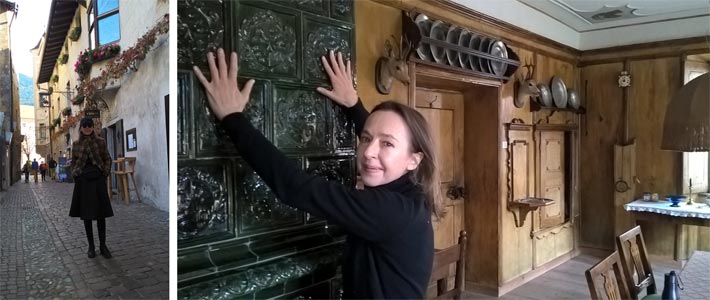19 November 2017
South Tyrol tour, part 1: Castle hopping, the finding of fashion and women's magazines of the mid-19th century, and the comparison to nowadays' fashion communication
South Tyrol tour, part 2: After walking through nature, I relaxed while reading at mid-19th century fashion magazines about women's movement activities
South Tyrol tour, part 3: Women as drivers of cabriolets, the depiction of women in art,... are themes in fashion and women's magazines of the years 1866, 1867
South Tyrol tour, part 4: Dresses made of toxic fabrics, health tips, bakery recipes,... - themes in 1866, 1867
by Fashionoffice publisher Karin Sawetz

On one day of the South Trol tour, I visited Brixen for lunch, made a sight-seeing tour through the town and warmed up later at a dining room with tiled stove and wood panelling in original Tyrolean style how it was fashion in the region of the times when the around 24-years old woman and owner of the issues of the fashion and women's magazines* published in 1866, 1867 once lived.
*'Damenkleider Magazin vereinigt mit Musterzeitung & Frauenzeitung' (could be translated as 'Women's Clothing Magazine united with Pattern Journal & Women's Journal'), published by the J. B. Metzler'schen Buchhandlung in Stuttgart, Germany
I took a closer look at the mid-19th century magazine rubric 'Küche und Haushalt' (Kitchen and Household) where health tips, beauty mixtures, reports about toxic fabrics or recipes for bakeries can be found.
Health Tip
At the issue of 1st May 1866, the Kitchen and Household writers recommended a therapy against burn wounds: packing the wound into a linseed oil and limewater mixture composed by the apothecary and opening the burn blister with the needle to let the liquid run out. Today, everybody knows that it's not a good idea to open such a blister. 21st century pharmacists offer high-perfomance medicine in one product which acts against the pain, heals the wound and removes the blister liquid without additional mechanical intervention! But it depends on the wound; even pharmacists when in doubt have to send the customer to the doctor. Early 21st century journalists would probably suggest how to fit up the emergency suitcase with burn wound bandage, etc for the first aid at home.
Beauty Tip
At the issue of 1st July 1866, the magazine published a recipe for a cucumber mask against skin blemishes. The mask isn't only complicated to prepare with heating and filtering procedures, it acts very slowly (over night!)! Additionally while the cucumber mask is working, the bed linen will probably gets dirty and no night cream can be applied. No woman would ever buy such a product today. The ingredients and the used energy for heating the vegetable sauce for producing the treatment costs money - more money than the necessary small amount from a tube of one of today's skin-type optimized face masks which can be washed off after some minutes.
Toxic Fabric
At the issue of 1st December 1866, one of the articles of the rubric 'Kitchen and Household' is about toxic fabric cases happened in Vienna where women wore clothes made of arsenic containing light-green silk. The physicians needed several days until they had found the reason for the women's illness caused by the coloring of the material. Reports about toxic fabrics appeared several times through 1866 and 1867.
Today, toxic materials in fabrics are well researched and test laboratories for new textile processing methods, finishing had been established already decades ago. The research and test laboratories are in many cases part of academic education institutions. The example of the green silk cases makes clear how close the fields medicine, chemical sciences and the production of fabrics are working together. Today we are facing a new challenge in textile technologies. Researchers experiment with the incorporation of robotic technologies and interactive features into fabrics. It's very probable that companies will have run tests in textile & robotic/artificial intelligence laboratories before products hit the markets. Another important aspect of the digitalisation of materials is privacy and data security of - for example, performance data which are collected via running gear.
Recipes
Even though the Almond Cookies (original 'Mandelbusserl') recipe at the issue of 1st February 1866 is similar to contemporary cooking instructions, mid-19th century culinary differs from today's cooking practice which is characterized by refined mixtures of more varied and exotic ingredients. Fashionoffice reported recently about a spice manufactory's Advent calendar concerning Christmas baking and cooking ideas with extraordinary spices or about a tea label's recipes for energizing dishes made with matcha.
'South Tyrol tour, part 5': Jewelry, traveling,... - themes in 1866, 1867 fashion and women's magazines
more culture>
|

